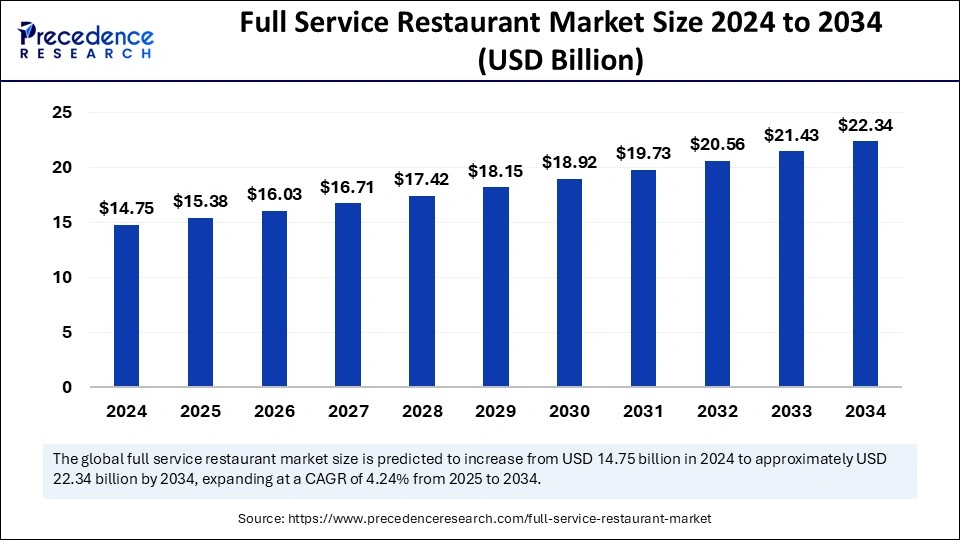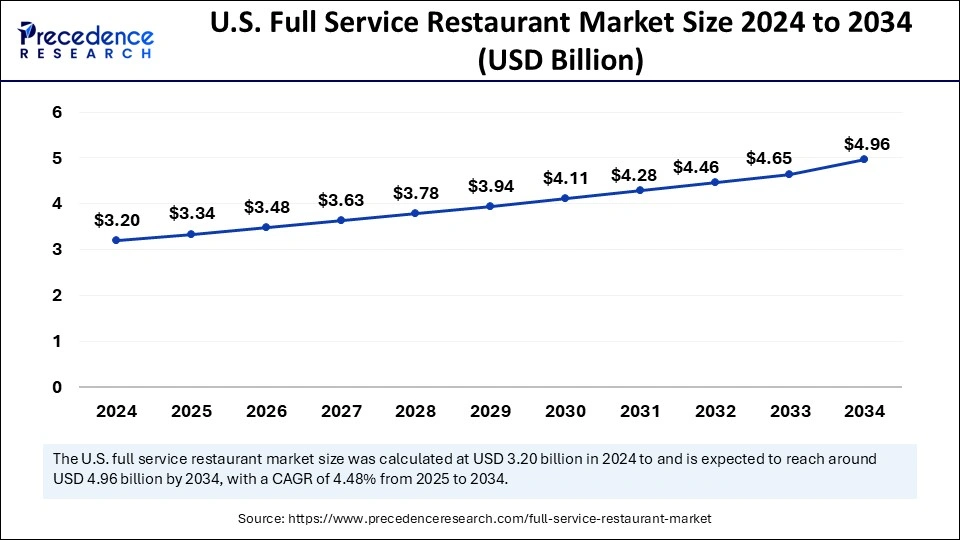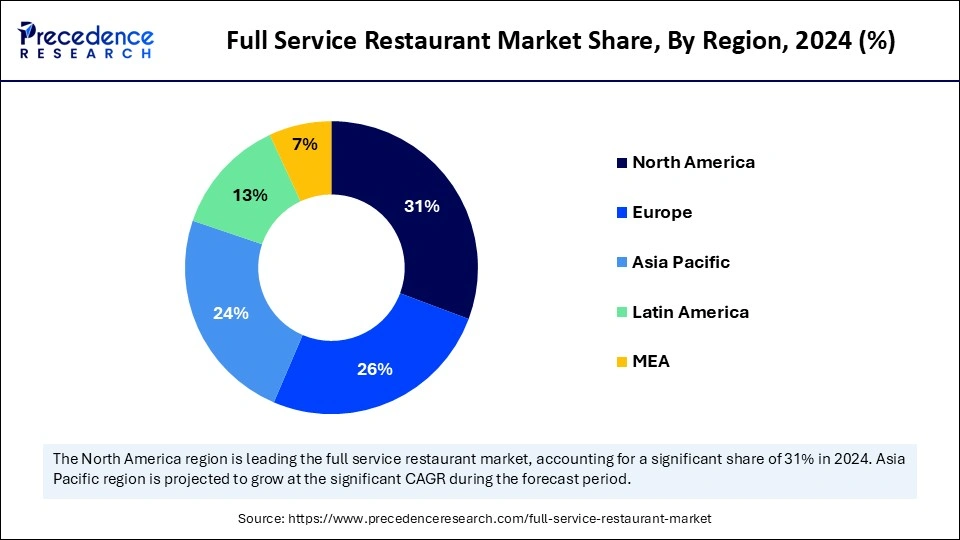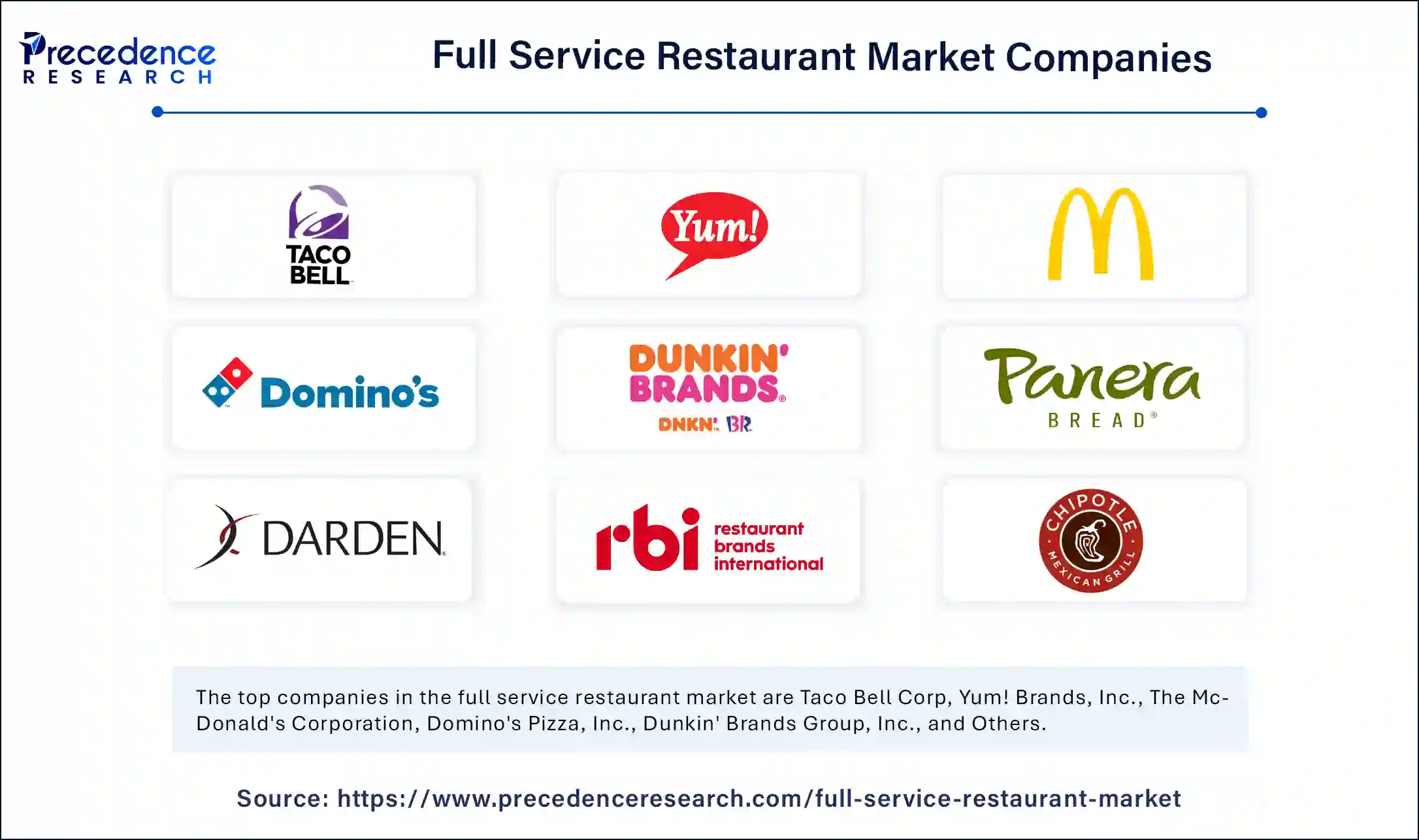August 2024
The global full service restaurant market size is calculated at USD 15.38 billion in 2025 and is forecasted to reach around USD 22.34 billion by 2034, accelerating at a CAGR of 4.24% from 2025 to 2034. The North America market size surpassed USD 4.57 billion in 2024 and is expanding at a CAGR of 4.42% during the forecast period. The market sizing and forecasts are revenue-based (USD Million/Billion), with 2024 as the base year.
The global full service restaurant market size accounted for USD 14.75 billion in 2024 and is predicted to increase from USD 15.38 billion in 2025 to approximately USD 22.34 billion by 2034, expanding at a CAGR of 4.24% from 2025 to 2034. The growing interest of consumers in gourmet as well as ethnic cuisines is expected to boost the growth of the market during the forecast period.

Artificial intelligence (AI) helps shape the landscape of many industries. In full-service restaurants, AI helps in various ways. Firstly, it helps enhance customer experience and satisfaction by analyzing past orders and food preferences to suggest dishes they will likely enjoy. Secondly, it optimizes restaurant operations by managing inventory levels. AI-powered chatbots and virtual assistants can help restaurants take orders, handle customer inquiries, and offer any required information. This helps restaurants allocate resources properly and helps the staff focus on complex tasks. Personalization of customer service and marketing is made easy with AI systems. Moreover, staff scheduling becomes easy as AI analyzes staffing needs, creating optimized schedules and predicting peak times. It helps businesses reduce labor costs while ensuring their operations are streamlined.
The U.S. full service restaurant market size was exhibited at USD 3.20 billion in 2024 and is projected to be worth around USD 4.96 billion by 2034, growing at a CAGR of 4.48% from 2025 to 2034.

North America registered dominance in the full service restaurant market by holding the largest share in 2024. This is mainly due to the high disposable income, allowing consumers to spend on dining out. With busy lifestyles, the popularity of dining out and utilizing food delivery services has increased among people. In addition, the availability and accessibility to full-services restaurants and well-established tourism industry contributed to regional market growth.
The U.S. and Canada play a major role in the North American full service restaurant market. The U.S. is home to a large number of leading market players. There is a rapid expansion of casual dining chains, along with a robust tourism industry, in the U.S. and Canada, supporting the market.
Asia Pacific is expected to experience the fastest growth during the forecast period. The popularity of food services is rising in the region due to the growing urbanization, especially in emerging countries like India, China, Indonesia, and South Korea. The rising disposable income and inclination of the population toward casual dining and delivery services are likely to boost regional market growth. In addition, the rapid expansion of the food & beverage industry contributes to market growth.

India is anticipated to have a stronghold on the Asia Pacific full service restaurant market. The growing younger population who are seeking improved dining out experience is one of the key factors supporting market growth. The increasing popularity of a combination of full-service restaurants and retail will further support the market’s growth. With changing food preferences and expanding tourism activities, there is a high demand for Asian cuisine, driving market growth.
Europe is projected to show notable growth in the foreseeable future. The increasing demand for improved dining experience and the rising popularity of ethnic cuisine are expected to support the European full service restaurant market. Germany is anticipated to play a key role in the market. The expansion of the casual dining chain and the growing tourism in the country propel the market. The country's increased disposable income and a rich culinary heritage further support market expansion
The landscape of the food services and dining industry is constantly evolving across the world. The full service restaurant market is witnessing rapid growth due to the rising urbanization and population growth, especially in urban countries. The rapid technological advancements are playing an important role and will continue to be crucial for the growth of this market. An increase in demand worldwide for options in food items, cuisines, and ambiances is boosting the market growth. The rising popularity of food delivery services, especially online delivery, is contributing to the growth of this market. A shift in expectations from the customers is helping bring innovation and push the boundaries of market expansion. Increasing disposable income and growing affinity for dining and delivery experiences are helping market growth. Key players are integrating technological advancements and offering exclusive food experiences focusing on quality and comfort, supporting the market’s growth.
| Report Coverage | Details |
| Market Size by 2034 | USD 22.34 Billion |
| Market Size in 2025 | USD 15.38 Billion |
| Market Size in 2024 | USD 14.75 Billion |
| Market Growth Rate from 2025 to 2034 | CAGR of 4.24% |
| Dominated Region | North America |
| Fastest Growing Market | Asia Pacific |
| Base Yeareny | 2024 |
| Forecast Period | 2025 to 2034 |
| Segments Covered | Restaurant Type, Menu Type, Service Type, and Regions |
| Regions Covered | North America, Europe, Asia-Pacific, Latin America, and Middle East & Africa |
An Increase in Consumer Demand for Dining Out
An increase in consumer demand for dining out across the world is a major factor driving the growth of the full service restaurant market. The rise in urbanization and disposable income per household significantly boosts the number of customers dining out. Full-service restaurants offer a wide range of food menus as well as drinks in a comfortable and relaxed setting. This makes these restaurants popular among consumers seeking enhanced dining out experience. People are opting for restaurants that would offer them a complete dining out experience.
Competition by Other Restaurants
The full service restaurant market faces tough competition from quick-service and fast-food restaurants. These outlets offer a limited number of food items, which are more affordable, along with faster service. The availability of these restaurants challenges the full-service establishments to attract a broader consumer base, specifically price-sensitive customers. With fluctuating raw materials and logistics prices, this market has to maintain certain price levels. The key players in this market must come up with new strategies, like loyalty programs, to broaden and cater to a wider consumer base.
Advancements in Technology
As advanced technologies are penetrating every aspect of life, their integration into full-service restaurants could help elevate the market to new heights. The rise in online ordering, booking services, and digital payments offer customer convenience, which is expected to boost market growth. Customers are looking for restaurants that offer them convenience. Integrating AI and machine learning models into the Point of Sale (POS) or other infrastructure helps improve operational efficiency and customer experience. A study revealed that 84% of full-service restaurants noticed a significant growth in revenue after investing and adopting advanced technologies into their operations. This proves that technological advancements create immense opportunities in the market.
The casual dining segment dominated the full service restaurant market by holding the largest share in 2024. The rise in disposable incomes and shifting lifestyle patterns encouraged more customers to choose casual dining options. These establishments offer a variety of cuisines and extensive menus that make them popular. The increase in demand for a convenient, comfortable, and affordable dining experience further bolstered the segment.
Meanwhile, the family dining segment held a significant share of the market in 2024 and is anticipated to grow at a steady rate in the coming years. The growing number of people choosing to spend time with their families and enjoy good food is expected to boost the segment growth. These establishments allow families to enjoy a meal together.
The ethnic cuisine segment led the full service restaurant market in 2024. This is mainly due to the rise in popularity of ethnic cuisine because it offers a special menu that brings out dishes of a specific culture. The rise in the diasporic population across the world and consumers’ willingness to experience different food cultures augmented the segment’s growth. Ethnic cuisine restaurants provide dishes with cooking methods and ingredients that are particular to a cuisine. This creates an authentic cultural food experience, which makes them an attractive option. The reflection of culture in flavors, food, and décor continues to aid this segment’s growth.
On the other hand, the Italian cuisine segment is predicted to grow at a significant rate during the forecast period. The increasing popularity of Italian cuisine around the world is a major factor supporting this segment’s growth. Most of the Italian dishes are healthy, attracting more consumers.
The table service segment held the largest share of the full service restaurant market in 2024. The comfort and personalized experience of table service is an important part of the consumer dining experience. Table service also provides an attentive dining experience, attracting customers seeking a quick meal.
The delivery services segment is expected to grow at a significant rate over the studied period. The growing popularity of delivery services, especially online delivery services, is anticipated to the segment’s growth. The convenience and ease of ordering food through delivery services from the comfort of home attract more consumers. Moreover, with busy lifestyles, people are preferring to order food online, supporting segmental growth.

By Restaurant Type
By Menu Type
By Service Type
By Region
For inquiries regarding discounts, bulk purchases, or customization requests, please contact us at sales@precedenceresearch.com
No cookie-cutter, only authentic analysis – take the 1st step to become a Precedence Research client
August 2024
August 2024